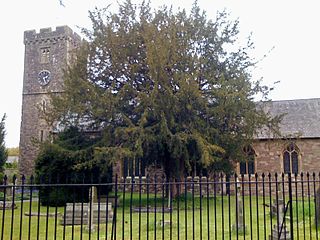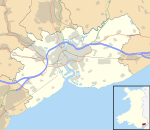
There are many Roman sites in Great Britain that are open to the public. There are also many sites that do not require special access, including Roman roads, and sites that have not been uncovered.

Caerleon is a town and community in Newport, Wales. Situated on the River Usk, it lies 5 miles (8 km) northeast of Newport city centre, and 5.5 miles (9 km) southeast of Cwmbran. Caerleon is of archaeological importance, being the site of a notable Roman legionary fortress, Isca Augusta, and an Iron Age hillfort. Close to the remains of Isca Augusta are the National Roman Legion Museum and the Roman Baths Museum. The town also has strong historical and literary associations: Geoffrey of Monmouth elevated the significance of Caerleon as a major centre of British history in his Historia Regum Britanniae, and Alfred Lord Tennyson wrote Idylls of the King (1859–1885) while staying in Caerleon.

Isca Dumnoniorum, also known simply as Isca, was originally a Roman legionary fortress for the Second Augustan Legion in the Roman province of Britannia at the site of present-day Exeter in Devon.

Amgueddfa Cymru – Museum Wales, branded as simply Amgueddfa Cymru, is a Welsh Government sponsored body that comprises seven museums in Wales:

Newport Museum and Art Gallery is a museum, library and art gallery in the city of Newport, South Wales. It is located in Newport city centre on John Frost Square and is adjoined to the Kingsway Shopping Centre.
Julius and Aaron were two Romano-British Christian saints who were martyred around the third century. Along with Saint Alban, they are the only named Christian martyrs from Roman Britain. Most historians place the martyrdom in Caerleon, although other suggestions have placed it in Chester or Leicester. Their feast day was traditionally celebrated on 1 July, but it is now observed together with Alban on 20 June by the Roman Catholic and Anglican Churches.

Venta Silurum was a town in Roman Britain (Britannia). Today it consists of remains in the village of Caerwent in Monmouthshire, south east Wales.

Deva Victrix, or simply Deva, was a legionary fortress and town in the Roman province of Britannia on the site of the modern city of Chester. The fortress was built by the Legio II Adiutrix in the 70s AD as the Roman army advanced north against the Brigantes, and rebuilt completely over the next few decades by the Legio XX Valeria Victrix. In the early 3rd century the fortress was again rebuilt. The legion probably remained at the fortress until the late 4th or early 5th century, upon which it fell into disuse.

Isca, variously specified as Isca Augusta or Isca Silurum, was the site of a Roman legionary fortress and settlement or vicus, the remains of which lie beneath parts of the present-day suburban town of Caerleon in the north of the city of Newport in South Wales. The site includes Caerleon Amphitheatre and is protected by Cadw.

Gobannium was a Roman fort and civil settlement or Castra established by the Roman legions invading what was to become Roman Wales and lies today under the market town of Abergavenny, Monmouthshire in south east Wales.

St Cadoc's Church is a Church in Wales church located in Caerleon, Newport, Wales and is Grade II* listed. It is one of many buildings associated with the travels of St Cadoc.

Caerleon Roman Fortress and Baths encompass the archaeological ruins and sites of the Legionary Fortress of Isca Augusta spread across the town of Caerleon, near the city of Newport, South Wales. Notable for being one of only three permanent legionary fortresses from Roman Britain, Caerleon has provided a unique opportunity to study the archaeology of a Roman Legionary fortress, less affected by the medieval and subsequent urban activity of most such fortresses. Having attracted the attention of eminent archaeologists throughout the 20th century it now has four major public archaeological venues, including the museum run by Cadw, called 'Caerleon Roman Fortress and Baths', featuring the excavated fortress bath-house. Also open to the public is the most complete excavated amphitheatre in Britain, a series of barracks and the National Roman Legion Museum. The fortress and its surrounding civil settlement have been the subject of continuing major archaeological investigations into the 21st century.

The Roman Bath is a public house in St Sampson's Square, in the city of York, in England. It is built above an ancient Roman bath house. The remains were uncovered during building work when the present pub was erected in 1929–31 replacing an inn. The exterior has Tudor Revival features including applied half-timbering. The pub is however more notable for the Roman remains which can be viewed inside.

The AdmiralCity of Newport Half Marathon is an annual half marathon race held in the Welsh city of Newport, Wales, taking place in March. The event was established in 2013, organised by the charity St. Davids Hospice Care.

The Tour de Gwent is an annual 6-route cycling event which begins in Caerleon, and follows a route through Newport and Monmouthshire. The event takes place in April each year.

The Mynde is a historic site and property located in Caerleon on the northern outskirts of the city of Newport. The town is the historic site of the Isca Augusta Roman Fortress.

The Hanbury Arms is a public house in Caerleon, near Newport, Wales. In the 19th century, Alfred, Lord Tennyson stayed at the inn, and began writing the Idylls of the King during his stay.

The archaeology of Wales is the study of human occupation within the country of Wales which has been occupied by modern humans since 225,000 BCE, with continuous occupation from 9,000 BCE. Analysis of the sites, artefacts and other archaeological data within Wales details its complex social landscape and evolution from Prehistoric times to the Industrial period. This study is undertaken by academic institutions, consultancies, charities as well as government organisations.























